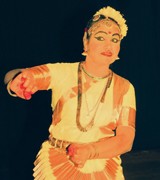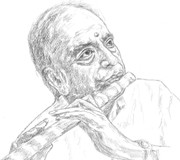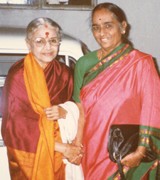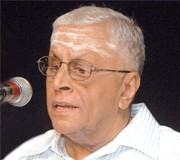SPECIAL FEATURE
Kalamandalam Sathyabhama: The mother of Mohini Attam
K.K. GOPALAKRISHNAN

Kalamandalam V. Sathyabhama, hailed as the “mother of Mohini Attam”, passed away on 13 September 2015 after being bedridden for a couple of months. She was 78. The art form has lost a person who nurtured it and was one of its strongest
pillars. Her contribution to the sustenance of Mohini Attam, as we see it today, is unmatched.
Sathyabhama’s last recorded interview was for me, and I am glad that I videographed this historic document for my personal footage. In December last year, she allowed my men to video-shoot her class at the Kalamandalam as a visiting professor.
SPECIAL FEATURE
N. Ramani: An ode to my guru
M.V. SWAROOP

I lost my teacher, Ramani Sir on the afternoon of 9 October 2015 and found myself, by the evening, in a whirlpool of reminiscences.
The traffic jam – a Bangalore special – had been particularly bad on the day I first met him. I was on a bus whose driver seemed averse to the idea of movement. I was already late, and decided to jump out and run the rest of the distance. I reached my destination a little late.
When I entered the house, without warning, I saw him. Shirtless, in a white veshti, with a towel in his hand, peering at me searchingly with his big eyes, he asked, “Yes?” One does not expect to come face-to-face with a celebrity this easily. I had grown up listening to his music, I had seen those very eyes peer at me through innumerable cassettes and CDs around my house. One CD, in which he had played a short Bilahari alapana, hardly four minutes long, scared me when I first heard it. I had not even started playing the flute then, but that recording always brought this question to my mind: Will I ever reach this Everest of achievement?
THE MS CENTURY
The pole star of Carnatic music
R. VEDAVALLI

In my childhood, in the early 1940s, we lived in Mannargudi, a town in the Tanjavur district of Tamil Nadu. We owned a gramophone player and my father would acquire records of Hindustani and Carnatic musicians alike and play them constantly. This was a time when the music of M.S. Subbulakshmi was being released in great numbers. It was her songs that drew me to music. As a six-year old I listened to all of them and would keep singing the songs incessantly. As providence would have it, Madurai Srirangam Iyengar – a musician of great repute – happened to hear me singing the songs. Recognising talent, he voluntarily took me on as a student in those tender years of mine.
Madurai Srirangam Iyengar and his elder brother Madurai Srinivasa Iyengar used to perform together as the Madura Brothers. It was under Srinivasa Iyengar that MS Amma’s early training began in Madurai. Many years later, MS Amma would fondly note on occasion that we both belonged to the same gurukulam. This has always been a matter of great
pride for me.
PROFILE
V. SUBRAHMANIAM (1934-2013)
JYOTHI GANESH

When you think of the late V. Subrahmaniam, the foremost quality that comes to mind is his unswerving devotion to his guru, Semmangudi Srinivasa Iyer and the Semmangudi bani.
Subrahmaniam was born on 6 November 1934 to Meenakshi and S. Vaidyanatha Iyer in the Princely State of Tiruvananthapuram. The immediate family saw great promise in the child, when he identified ragas and picked up songs naturally without any formal training. His musical career formally began in 1951 at the age of 17 (somewhat late compared to the rush of today’s young prodigies), under the tutelage of Prof. Sankara Iyer from the Swati Tirunal Music Academy. Despite the late start, he soon went on to give his maiden performance in 1953, such was his confidence and performance skill. His real break came in 1956 when he came under the wing of the doyen and ace teacher, Semmangudi Srinivasa Iyer, with whom he was closely associated for the next 50 years until Semmangudi passed away.


